Coupling between Diagenetic Environment and Porosity Evolution—A Quantitative Study of the Zhuhai Formation in the Huizhou Sag, Pearl River Mouth Basin, South China Sea
Abstract
:1. Introduction
2. Geological Background
3. Methods
3.1. Sampling and Analytical Techniques
3.2. Reconstruction of Porosity Evolution (PIBS Method)
3.2.1. Fitting of Porosity
3.2.2. Calculation of Porosity Evolution
4. Results
4.1. Petrographical Characteristics
4.1.1. Detrital Composition
4.1.2. Detrital Texture
4.2. Fluid Inclusion Analysis
4.3. Fluorescence Analysis
4.4. Diagenetic Events and Characteristics
4.4.1. Compaction
4.4.2. Cementation
4.4.3. Dissolution
4.5. Quantitative Analysis of the Porosity Evolution
5. Discussion
5.1. Diagenetic Evolution and Environment
5.1.1. Evolution of Sandstone Diagenesis
5.1.2. Diagenetic Environment
5.2. Reconstruction of Diagenetic History
5.2.1. Eogenesis Stage
5.2.2. Mesogenesis Stage
5.3. Controlling Factors of Reservoir Quality
5.3.1. Initial Detrital Composition and Texture
5.3.2. Diagenetic Processes
6. Conclusions
Author Contributions
Funding
Conflicts of Interest
Appendix A. Porosity Evolution Statistics
| Well | Depth (m) | Pi (%) | Pgd (%) | Pcd (%) | S0 | Pa (%) | Φa (%) | Φ0 (%) | ΦL (%) | ΦCL (%) | ΦD (%) |
|---|---|---|---|---|---|---|---|---|---|---|---|
| L19-1 | 3248.50 | 9.60 | 1.43 | 0.00 | 1.41 | 4.50 | 11.03 | 37.15 | 27.05 | 0.50 | 1.43 |
| L19-1 | 3283.40 | 8.83 | 1.44 | 0.00 | 1.26 | 4.00 | 10.27 | 39.01 | 29.18 | 1.00 | 1.44 |
| L19-1 | 3313.20 | 12.63 | 4.67 | 0.00 | 1.26 | 8.62 | 17.30 | 39.02 | 25.39 | 1.00 | 4.67 |
| L19-1 | 3362.20 | 10.31 | 3.81 | 0.00 | 1.46 | 6.53 | 14.12 | 36.63 | 26.32 | 0.00 | 3.81 |
| L19-1 | 3366.40 | 11.65 | 1.74 | 0.00 | 1.29 | 6.05 | 13.39 | 38.64 | 26.99 | 0.00 | 1.74 |
| L19-1 | 3403.50 | 13.25 | 2.52 | 0.00 | 1.23 | 7.62 | 15.78 | 39.58 | 26.33 | 0.00 | 2.52 |
| L19-1 | 3427.50 | 12.03 | 1.80 | 0.00 | 1.25 | 6.34 | 13.83 | 39.22 | 27.19 | 0.00 | 1.80 |
| L19-1 | 3439.50 | 6.03 | 2.74 | 2.19 | 1.46 | 4.45 | 10.96 | 36.59 | 2.37 | 28.19 | 4.93 |
| L19-1 | 3445.50 | ||||||||||
| L19-1 | 3464.20 | 14.36 | 2.74 | 0.00 | 1.28 | 8.49 | 17.10 | 38.75 | 21.39 | 3.00 | 2.74 |
| L19-1 | 3473.40 | 8.16 | 4.50 | 1.41 | 1.29 | 6.50 | 14.07 | 38.61 | 4.04 | 26.41 | 5.91 |
| L19-1 | 3490.00 | 15.10 | 2.26 | 0.00 | 1.60 | 8.66 | 17.36 | 35.24 | 20.14 | 0.00 | 2.26 |
| L19-1 | 3499.50 | 13.40 | 3.56 | 0.00 | 1.20 | 8.40 | 16.96 | 39.94 | 26.54 | 0.00 | 3.56 |
| L19-1 | 3522.00 | 9.87 | 2.32 | 0.00 | 1.23 | 5.26 | 12.19 | 39.52 | 29.65 | 0.00 | 2.32 |
| L19-1 | 3536.20 | 8.56 | 1.17 | 0.00 | 1.24 | 3.64 | 9.72 | 39.31 | 25.26 | 5.50 | 1.17 |
| L19-1 | 3542.00 | 11.36 | 2.84 | 0.00 | 1.22 | 6.58 | 14.20 | 39.71 | 26.85 | 1.50 | 2.84 |
| L19-1 | 3551.80 | ||||||||||
| L19-1 | 3562.50 | 8.00 | 2.67 | 0.00 | 1.50 | 4.26 | 10.67 | 36.18 | 13.18 | 15.00 | 2.67 |
| L19-1 | 3576.20 | ||||||||||
| L19-1 | 3587.20 | 10.21 | 0.54 | 0.00 | 1.22 | 4.31 | 10.74 | 39.69 | 24.48 | 5.00 | 0.54 |
| L19-1 | 3598.20 | 8.43 | 1.26 | 0.00 | 1.37 | 3.62 | 9.69 | 37.62 | 28.69 | 0.50 | 1.26 |
| L19-1 | 3603.50 | 11.81 | 3.33 | 0.00 | 1.23 | 7.20 | 15.14 | 39.57 | 27.27 | 0.50 | 3.33 |
| L19-1 | 3622.50 | 10.36 | 0.90 | 0.00 | 1.27 | 4.65 | 11.26 | 38.93 | 24.57 | 4.00 | 0.90 |
| L19-1 | 3636.00 | 10.70 | 2.19 | 0.00 | 1.24 | 5.72 | 12.89 | 39.37 | 3.68 | 25.00 | 2.19 |
| L19-2 | 3295.00 | 19.91 | 5.95 | 0.00 | 1.31 | 14.25 | 25.86 | 38.45 | 14.53 | 4.00 | 5.95 |
| L19-2 | 3453.00 | 15.41 | 4.10 | 0.00 | 1.24 | 4.31 | 19.50 | 39.44 | 13.83 | 10.20 | 4.10 |
| L19-2 | 3462.20 | 13.28 | 2.72 | 0.00 | 1.19 | 6.22 | 16.00 | 40.21 | 22.73 | 4.20 | 2.72 |
| L19-2 | 3476.90 | 18.42 | 2.28 | 0.00 | 1.24 | 12.20 | 20.70 | 39.38 | 18.35 | 2.60 | 2.28 |
| L19-2 | 3591.40 | 18.33 | 2.27 | 0.00 | 1.23 | 14.92 | 20.60 | 39.47 | 15.64 | 5.50 | 2.27 |
| L19-2 | 3673.50 | 7.75 | 5.95 | 0.14 | 1.23 | 6.34 | 13.83 | 39.49 | 28.80 | 2.94 | 6.09 |
| L19-2 | 3674.50 | 7.32 | 3.77 | 0.00 | 1.38 | 4.54 | 11.09 | 37.56 | 28.74 | 1.50 | 3.77 |
| L19-2 | 3681.50 | 7.14 | 2.38 | 0.00 | 1.25 | 3.51 | 9.53 | 39.23 | 28.59 | 3.50 | 2.38 |
| L19-2 | 3683.00 | 6.72 | 2.88 | 0.00 | 1.25 | 3.56 | 9.60 | 39.16 | 30.44 | 2.00 | 2.88 |
| L19-2 | 3686.38 | 4.90 | 2.74 | 0.66 | 1.42 | 3.51 | 8.30 | 37.05 | 23.89 | 8.26 | 3.40 |
| L19-2 | 3687.00 | 8.42 | 2.66 | 0.00 | 1.25 | 4.53 | 11.08 | 39.20 | 28.28 | 2.50 | 2.66 |
| L19-2 | 3678.88 | 11.21 | 1.40 | 0.13 | 1.30 | 5.62 | 12.74 | 38.47 | 23.14 | 4.13 | 1.53 |
| L19-2 | 3688.14 | 9.63 | 1.57 | 0.00 | 1.50 | 4.84 | 11.20 | 36.18 | 21.34 | 5.20 | 1.57 |
| L19-2 | 3690.62 | 11.17 | 2.13 | 0.00 | 1.50 | 5.87 | 13.30 | 36.18 | 20.50 | 4.50 | 2.13 |
| L19-2 | 3691.00 | 11.23 | 1.39 | 0.00 | 1.30 | 5.54 | 12.61 | 38.53 | 26.31 | 1.00 | 1.39 |
| L19-3 | 3104.80 | 18.47 | 6.83 | 0.00 | 1.27 | 15.65 | 25.30 | 38.93 | 19.16 | 1.30 | 6.83 |
| L19-3 | 3110.50 | 19.34 | 5.46 | 0.00 | 1.27 | 13.65 | 24.80 | 38.96 | 17.12 | 2.50 | 5.46 |
| L19-3 | 3121.00 | 19.01 | 3.89 | 0.00 | 1.33 | 10.83 | 22.90 | 38.17 | 17.66 | 1.50 | 3.89 |
| L19-3 | 3159.00 | 21.12 | 2.64 | 0.24 | 1.30 | 12.70 | 24.00 | 38.53 | 15.67 | 1.74 | 2.88 |
| L19-3 | 3165.00 | 22.79 | 1.72 | 0.00 | 1.40 | 12.88 | 24.50 | 37.27 | 11.98 | 2.50 | 1.72 |
| L19-3 | 3167.00 | 19.40 | 2.40 | 0.00 | 1.28 | 9.16 | 21.80 | 38.85 | 17.45 | 2.00 | 2.40 |
| L19-3 | 3171.00 | 21.84 | 3.56 | 0.00 | 1.20 | 12.14 | 25.40 | 39.95 | 14.61 | 3.50 | 3.56 |
| L19-3 | 3173.00 | 19.07 | 3.41 | 0.23 | 1.21 | 9.53 | 22.70 | 39.80 | 19.00 | 1.73 | 3.63 |
| L19-3 | 3218.00 | 21.25 | 3.75 | 0.00 | 1.26 | 10.51 | 25.00 | 39.04 | 15.29 | 2.50 | 3.75 |
| L21-18 | 3290.49 | 10.75 | 2.05 | 0.00 | 1.46 | 2.54 | 12.80 | 36.59 | 23.84 | 2.00 | 2.05 |
| L21-18 | 3294.00 | 6.44 | 1.14 | 0.00 | 1.35 | 0.52 | 7.58 | 37.89 | 29.45 | 2.00 | 1.14 |
| L21-18 | 3308.01 | 6.74 | 0.35 | 0.00 | 1.24 | 0.23 | 7.09 | 39.41 | 12.67 | 20.00 | 0.35 |
| L21-18 | 3338.01 | 5.44 | 0.00 | 0.00 | 1.27 | 0.00 | 5.44 | 38.99 | 33.55 | 0.00 | 0.00 |
| L21-18 | 3339.99 | ||||||||||
| L21-18 | 3344.99 | 9.92 | 2.48 | 0.00 | 1.35 | 2.43 | 12.40 | 37.85 | 25.43 | 2.50 | 2.48 |
| L21-18 | 3433.50 | 9.04 | 1.12 | 0.00 | 1.33 | 2.07 | 10.16 | 38.08 | 26.03 | 3.00 | 1.12 |
| L21-6 | 3697.50 | 9.91 | 1.61 | 0.00 | 1.27 | 2.89 | 11.53 | 38.88 | 27.97 | 1.00 | 1.61 |
| L21-6 | 3722.00 | 9.36 | 1.78 | 0.00 | 1.24 | 2.66 | 11.14 | 39.40 | 29.54 | 0.50 | 1.78 |
| L21-6 | 3745.00 | 8.58 | 2.59 | 0.59 | 1.27 | 3.03 | 11.76 | 38.95 | 27.78 | 2.59 | 3.18 |
| L21-6 | 3776.00 | 7.24 | 1.69 | 0.47 | 1.23 | 5.22 | 9.40 | 39.52 | 30.81 | 1.47 | 2.16 |
| L21-7 | 3458.70 | 2.20 | 0.00 | 0.00 | 1.32 | 0.00 | 2.20 | 38.23 | 32.03 | 4.00 | 0.00 |
| L21-7 | 3500.80 | 10.14 | 1.93 | 0.00 | 1.32 | 1.96 | 12.07 | 38.29 | 24.65 | 3.50 | 1.93 |
| L21-7 | 3549.80 | 7.51 | 1.43 | 0.00 | 1.21 | 1.34 | 8.94 | 39.90 | 31.39 | 1.00 | 1.43 |
| L22-2 | 3580.00 | 11.45 | 1.00 | 0.00 | 1.27 | 3.44 | 12.44 | 38.96 | 25.51 | 2.00 | 1.00 |
| L22-2 | 3592.50 | 10.13 | 0.89 | 0.11 | 1.24 | 2.65 | 11.13 | 39.38 | 26.15 | 3.11 | 1.00 |
| L22-2 | 3630.00 | 10.65 | 1.88 | 0.00 | 1.29 | 3.49 | 12.53 | 38.65 | 26.01 | 2.00 | 1.88 |
| L22-2 | 3660.00 | 6.77 | 0.84 | 0.00 | 1.34 | 1.29 | 7.60 | 38.05 | 29.29 | 2.00 | 0.84 |
| L22-2 | 3753.00 | 11.90 | 1.18 | 0.00 | 1.29 | 4.33 | 13.08 | 38.61 | 24.71 | 2.00 | 1.18 |
| L22-2 | 3834.00 | 8.51 | 1.16 | 0.00 | 1.33 | 3.52 | 9.67 | 38.09 | 28.58 | 1.00 | 1.16 |
| L22-2 | 3880.50 | 8.68 | 1.53 | 0.00 | 1.23 | 2.10 | 10.21 | 39.54 | 28.86 | 2.00 | 1.53 |
| L22-2 | 3882.00 | 8.15 | 0.92 | 0.09 | 1.49 | 2.15 | 9.16 | 36.29 | 23.55 | 4.59 | 1.01 |
| L22-2 | 3888.00 | 10.02 | 0.64 | 0.00 | 1.27 | 2.96 | 10.66 | 38.97 | 26.95 | 2.00 | 0.64 |
| L22-2 | 3936.50 | 11.16 | 0.59 | 0.00 | 1.27 | 3.02 | 11.74 | 38.94 | 26.78 | 1.00 | 0.59 |
| L22-2 | 3937.50 | 6.57 | 1.75 | 0.00 | 1.41 | 1.29 | 8.32 | 37.11 | 28.54 | 2.00 | 1.75 |
| L22-2 | 3934.40 | 9.28 | 1.03 | 0.00 | 1.33 | 2.16 | 10.31 | 38.18 | 27.40 | 1.50 | 1.03 |
| L22-2 | 3950.00 | 8.83 | 1.09 | 0.00 | 1.30 | 1.93 | 9.93 | 38.55 | 28.72 | 1.00 | 1.09 |
| L22-2 | 4032.10 | 6.71 | 0.00 | 0.00 | 1.38 | 0.00 | 6.71 | 37.48 | 0.77 | 30.00 | 0.00 |
| L25-11 | 3157.00 | 12.99 | 1.46 | 0.15 | 1.28 | 8.82 | 14.60 | 38.82 | 24.18 | 1.65 | 1.61 |
| L25-11 | 3237.60 | 13.23 | 0.84 | 0.00 | 1.46 | 6.50 | 14.07 | 36.61 | 22.88 | 0.50 | 0.84 |
| L25-11 | 3238.70 | 11.13 | 1.38 | 0.00 | 1.68 | 7.83 | 12.50 | 34.54 | 22.91 | 0.50 | 1.38 |
| L25-11 | 3239.50 | 15.23 | 0.97 | 0.00 | 1.30 | 7.90 | 16.20 | 38.54 | 22.81 | 0.50 | 0.97 |
| L25-11 | 3242.00 | 12.97 | 0.83 | 0.00 | 1.22 | 12.64 | 13.80 | 39.72 | 25.25 | 1.50 | 0.83 |
| L25-11 | 3312.40 | 3.43 | 0.39 | 0.08 | 1.83 | 0.58 | 3.90 | 33.46 | 0.95 | 29.08 | 0.47 |
| L25-11 | 3313.50 | 4.66 | 0.25 | 0.00 | 1.40 | 7.25 | 4.90 | 37.25 | 1.59 | 31.00 | 0.25 |
| L25-11 | 3321.01 | 0.00 | 5.49 | 0.61 | 1.38 | 3.97 | 6.10 | 37.49 | 1.88 | 35.61 | 6.10 |
References
- Fic, J.; Pedersen, P.K. Reservoir characterization of a “tight” oil reservoir, the middle Jurassic Upper Shaunavon Member in the Whitemud and Eastbrook pools, SW Saskatchewan. Mar. Pet. Geol. 2013, 44, 41–59. [Google Scholar] [CrossRef]
- Stroker, T.M.; Harris, N.B.; Crawford Elliott, W.; Marion Wampler, J. Diagenesis of a tight gas sand reservoir: Upper Cretaceous Mesaverde Group, Piceance Basin, Colorado. Mar. Pet. Geol. 2013, 40, 48–68. [Google Scholar] [CrossRef]
- Worden, R.H.; Burley, S. Sandstone Diagenesis: The Evolution of Sand to Stone. Sandstone Diagenesis 2009, 4, 3–44. [Google Scholar]
- Slatt, R.M. Chapter 5—Basics of Sequence Stratigraphy for Reservoir Characterization. In Developments in Petroleum Science; Slatt, R.M., Ed.; Elsevier: Amsterdam, The Netherlands, 2013; Volume 61, pp. 203–228. [Google Scholar]
- Athy, L.F. Density, Porosity, and Compaction of Sedimentary Rocks1. AAPG Bull. 1930, 14, 1–24. [Google Scholar]
- Schmoker, J.W.; Gautier, D.L. Sandstone porosity as a function of thermal maturity. Geology 1988, 16, 1007–1010. [Google Scholar] [CrossRef]
- Scherer, M. Parameters Influencing Porosity in Sandstones: A Model for Sandstone Porosity Prediction1. AAPG Bull. 1987, 71, 485–491. [Google Scholar] [CrossRef]
- Jiang, S.; Henriksen, S.; Wang, H.; Lu, Y.; Ren, J.; Cai, D.; Feng, Y.; Weimer, P. Sequence-stratigraphic architectures and sand-body distribution in Cenozoic rifted lacustrine basins, east China. AAPG Bull. 2013, 97, 1447–1475. [Google Scholar] [CrossRef]
- Taylor, T.R.; Giles, M.R.; Hathon, L.A.; Diggs, T.N.; Braunsdorf, N.R.; Birbiglia, G.V.; Kittridge, M.G.; Macaulay, C.I.; Espejo, I.S. Sandstone diagenesis and reservoir quality prediction: Models, myths, and reality. AAPG Bull. 2010, 94, 1093–1132. [Google Scholar] [CrossRef]
- Lander, R.H.; Bonnell, L.M. A model for fibrous illite nucleation and growth in sandstones. AAPG Bull. 2010, 94, 1161–1187. [Google Scholar] [CrossRef]
- Umar, M.; Friis, H.; Khan, A.S.; Kassi, A.M.; Kasi, A.K. The effects of diagenesis on the reservoir characters in sandstones of the Late Cretaceous Pab Formation, Kirthar Fold Belt, southern Pakistan. J. Asian Earth Sci. 2011, 40, 622–635. [Google Scholar] [CrossRef]
- Houseknecht, D.W. Assessing the Relative Importance of Compaction Processes and Cementation to Reduction of Porosity in Sandstones1. AAPG Bull. 1987, 71, 633–642. [Google Scholar]
- Ehrenberg, S.N. Assessing the Relative Importance of Compaction Processes and Cementation to Reduction of Porosity in Sandstones: Discussion; Compaction and Porosity Evolution of Pliocene Sandstones, Ventura Basin, California: Discussion1. AAPG Bull. 1989, 73, 1274–1276. [Google Scholar]
- Ge, J.; Qin, C.; Zhu, X.; Chen, S.; Liu, Y.; Zang, X. Characteristics and origin of low porosity and low permeability sandstone reservoir of Wenchang Formation in HZ25-7 structural belt of Huizhou Depression. Lithol. Reserv. 2014, 26, 36–43. [Google Scholar]
- Henares, S.; Caracciolo, L.; Cultrone, G.; Fernández, J.; Viseras, C. The role of diagenesis and depositional facies on pore system evolution in a Triassic outcrop analogue (SE Spain). Mar. Pet. Geol. 2014, 51, 136–151. [Google Scholar] [CrossRef]
- Zhu, H.; Zhong, D.; Yao, J.; Sun, H.; Niu, X.; Liang, X.; You, Y.; Li, X. Alkaline diagenesis and its effects on reservoir porosity: A case study of Upper Triassic Chang 7 tight sandstones in Ordos Basin, NW China. Pet. Geol. Exp. 2015, 42, 51–59. [Google Scholar] [CrossRef]
- Li, J. Temporal-spatial evolution of diagenetic environment and diagenesis pore evolutionary process of red beds in the eastern Dongying Sag, Bohai Bay Basin. Oil Gas Geol. 2017, 38, 90–97. [Google Scholar]
- Chester, J.S.; Lenz, S.C.; Chester, F.M.; Lang, R.A. Mechanisms of compaction of quartz sand at diagenetic conditions. Earth Planet. Sci. Lett. 2004, 220, 435–451. [Google Scholar] [CrossRef]
- Hao, G.; Shan, X.; Liu, W.; Wang, Q. Quantitative research of diagenesis: Its effect on pore evolution of the Fuyu oil reservoir in the north Qijia region. J. China Univ. Min. Technol. 2010, 20, 770–777. [Google Scholar] [CrossRef]
- Yang, R.; Fan, A.; Han, Z.; Wang, X. Diagenesis and porosity evolution of sandstone reservoirs in the East II part of Sulige gas field, Ordos Basin. Int. J. Min. Sci. Technol. 2012, 22, 311–316. [Google Scholar] [CrossRef]
- Wang, Y.; Cao, Y.; Xi, K.; Song, G.; Liu, H. A recovery method for porosity evolution of clastic reservoirs with geological time: A case study from the upper submember of Es4 in the Dongying depression, Jiyang Subbasin. Acta Pet. Sin. 2013, 34, 1100–1111. [Google Scholar]
- Feng, X.; Liu, L.; Li, Z.; Dou, W.; Zheng, S. Improvement and application of quantitative calculation of porosity evolution of clastic rock. Oil Gas Geol. 2017, 38, 1198–1207. [Google Scholar]
- Zhang, Q.; Sun, W.; Yang, X.; Li, H. Quantitative calculation of tight sandstone reservoir porosity evolution based on different diagenesis:A case study of Chang 6_3 reservoir in Huaqing area,Ordos Basin. Pet. Geol. Exp. 2017, 39, 126–133. [Google Scholar]
- Chen, R.; Luo, X.; Wu, Y. Construction of hydrocarbon passage framework using diagenetic sequence information. Acta Pet. Sin. 2007, 28, 43. [Google Scholar]
- Lu, J.; Zhao, Y.; Zhu, P.; Yuan, Q.; Li, S.; Deng, X. Application of Porosity Inversion Method to Reservoir Quantitative Prediction:Taking Wenchang Area in Zhu III Depression as an Example. Geol. Sci. Technol. Inf. 2018, 37, 105–114. [Google Scholar] [CrossRef]
- Ehrenberg, S.N. Preservation of Anomalously High Porosity in Deeply Buried Sandstones by Grain-Coating Chlorite: Examples from the Norwegian Continental Shelf1. AAPG Bull. 1993, 77, 1260–1286. [Google Scholar]
- Berger, G.; Cadore, E.; Schott, J.; Dove, P.M. Dissolution rate of quartz in lead and sodium electrolyte solutions between 25 and 300 °C: Effect of the nature of surface complexes and reaction affinity. Geochim. Cosmochim. Acta 1994, 58, 541–551. [Google Scholar] [CrossRef]
- Lanson, B.; Beaufort, D.; Berger, G.; Bauer, A.; Cassagnabere, A.; Meunier, A. Authigenic kaolin and illitic minerals during burial diagenesis of sandstones: A review. Clay Miner. 2002, 37, 1–22. [Google Scholar] [CrossRef]
- Cui, Y.; Cao, L.; Qiao, P.; Chen, S.; Pang, X.; Shao, L. Provenance Evolution of Paleogene Sequence (Northern South China Sea) Based on Detrital Zircon U-Pb Dating Analysis. Earth Sci. 2018, 43, 4169–4179. [Google Scholar]
- Deng, H.; Zheng, W. Depositional Characteristics of Offshore Tidal Deposits in the Lower Tertiary Zhuhai Formation, Huizhou Depression, Pearl River Mouth Basin. Geoscience 2009, 23, 767–775. [Google Scholar]
- Duan, W.; Luo, C.; Lou, Z.; Liu, J.; Jin, A.; Zhu, R. Diagenetic differences caused by the charging of natural gases with various compositions—A case study on the lower Zhuhai Formation clastic reservoirs in the WC-A sag, the Pearl River Mouth Basin. Mar. Pet. Geol. 2017, 81, 149–168. [Google Scholar] [CrossRef]
- Jiang, H.; Pang, X.; Shi, H.; Yu, Q.; Cao, Z.; Yu, R.; Chen, D.; Long, Z.; Jiang, F. Source rock characteristics and hydrocarbon expulsion potential of the Middle Eocene Wenchang formation in the Huizhou depression, Pearl River Mouth basin, south China sea. Mar. Pet. Geol. 2015, 67, 635–652. [Google Scholar] [CrossRef]
- Li, X. Sedimentary Facies and Paleogeographic Evolution of Huizhou Depression, Zhujiang Basin in Neogene. Master’s Thesis, Chengdu University of Technology, Chengdu, China, 2007. [Google Scholar]
- Peng, J.; Pang, X.; Peng, H.; Ma, X.; Shi, H.; Zhao, Z.; Xiao, S.; Zhu, J. Geochemistry, origin, and accumulation of petroleum in the Eocene Wenchang Formation reservoirs in Pearl River Mouth Basin, South China Sea: A case study of HZ25-7 oil field. Mar. Pet. Geol. 2017, 80, 154–170. [Google Scholar] [CrossRef]
- Peng, J.; Pang, X.; Shi, H.; Peng, H.; Xiao, S.; Yu, Q.; Wu, L. Hydrocarbon generation and expulsion characteristics of Eocene source rocks in the Huilu area, northern Pearl River Mouth basin, South China Sea: Implications for tight oil potential. Mar. Pet. Geol. 2016, 72, 463–487. [Google Scholar] [CrossRef]
- Su, M.; Alves, T.M.; Li, W.; Sha, Z.; Hsiung, K.-H.; Liang, J.; Kuang, Z.; Wu, N.; Zhang, B.; Chiang, C.-S. Reassessing two contrasting Late Miocene-Holocene stratigraphic frameworks for the Pearl River Mouth Basin, northern South China Sea. Mar. Pet. Geol. 2019, 102, 899–913. [Google Scholar] [CrossRef]
- Wang, C.; Wen, S.; Liang, X.; Shi, H.; Liang, X. Detrital zircon provenance record of the Oligocene Zhuhai Formation in the Pearl River Mouth Basin, northern South China Sea. Mar. Pet. Geol. 2018, 98, 448–461. [Google Scholar] [CrossRef]
- Wei, Q.; Zheng, R.; Shi, H.; Du, J.; Li, X. High Resolution Sequence Stratigraphic Characteristics of the Paleogene Zhuhai Formation in Huizhou Depression Marine Delta. Acta Sedimentol. Sin. 2008, 26, 744–752. [Google Scholar]
- Yan, H. Reservoir Description and Prediction of HZ19 Block in Huizhou Depression. Master’s Thesis, China University of Geosciences, Beijing, China, 2010. [Google Scholar]
- Zhu, M.; Dai, Y.; Zhu, J.; Shu, Y.; Lin, H.; Pang, X.; Jiang, H. Geological characteristics and accumulation mechanism of Paleocene reservoir in Huizhou sag,Pearl River Mouth basin. China Offshore Oil Gas 2017, 29, 1–11. [Google Scholar]
- Cheng, P.; Xiao, X.M.; Tian, H.; Huang, B.J.; Wilkins, R.W.T.; Zhang, Y.Z. Source controls on geochemical characteristics of crude oils from the Qionghai Uplift in the western Pearl River Mouth Basin, offshore South China Sea. Mar. Pet. Geol. 2013, 40, 85–98. [Google Scholar] [CrossRef]
- Long, G.; Shi, H.; Zheng, R.; Du, J.; Chen, S.; Ge, Y. Characteristics and development controlling factors of Paleogene deep reservoirs in Huizhou depression, Pearl River Mouth basin. Mar. Orig. Pet. Geol. 2011, 16, 71–78. [Google Scholar]
- Long, G.; Shi, H.; Zheng, R.; Du, J.; Liu, J.; Zhang, X. Diagenesis and porosity evolution of deep reservoirs in Huizhou depression, Pearl River Mouth basin. Acta Petrol. Mineral. 2011, 30, 665–673. [Google Scholar]
- Xiao, S. The geological Feature and Mechanism of Hydrocarbon Accumulation of Huizhou 27 Area. Master’s Thesis, China University of Petroleum, Beijing, China, 2016. [Google Scholar]
- Zhang, Y. Characteristies and Main Controlling Faetors of Hydrocarbon Aceumulation in the Eogene of Huizhou Depression. Master’s Thesis, China University Of Geosciences, Wuhan, China, 2011. [Google Scholar]
- Cui, S.; He, J.; Shenghong, C.; Zou, H.; Cui, J. Development Characteristics of Pearl River Mouth Basin and Its Geological Conditions for Oil and Gas Accumulation. Nat. Gas Geosci. 2009, 20, 384–391. [Google Scholar]
- Gong, Z.; Li, S.; Xie, J. Continental Margin Basin Analysis and Hydrocarbon Accumulation of the Northern South. China Sea; Science Press: Beijing, China, 1997; p. 510. [Google Scholar]
- Robison, C.R.; Elrod, L.W.; Bissada, K.K. Petroleum generation, migration, and entrapment in the Zhu 1 depression, Pearl River Mouth basin, South China Sea. Int. J. Coal Geol. 1998, 37, 155–178. [Google Scholar] [CrossRef]
- Zhang, C.; Li, S.; Yang, J.; Yang, S.; Wang, J. Petroleum migration and mixing in the Pearl River Mouth Basin, South China Sea. Mar. Pet. Geol. 2004, 21, 215–224. [Google Scholar] [CrossRef]
- Zhu, M.; Graham, S.; Pang, X.; McHargue, T. Characteristics of migrating submarine canyons from the middle Miocene to present: Implications for paleoceanographic circulation, northern South China Sea. Mar. Pet. Geol. 2010, 27, 307–319. [Google Scholar] [CrossRef]
- Zhao, F.; Wu, S.; Sun, Q.; Huuse, M.; Li, W.; Wang, Z. Submarine volcanic mounds in the Pearl River Mouth Basin, northern South China Sea. Mar. Geol. 2014, 355, 162–172. [Google Scholar] [CrossRef]
- Zhang, Y.F.; Sun, Z. A study of faulting patterns in the Pearl River Mouth Basin through analogue modeling. Mar. Geophys. Res. 2013, 34, 209–219. [Google Scholar] [CrossRef]
- Zhang, W.; Liang, J.; Lu, J.A.; Wei, J.; Su, P.; Fang, Y.; Guo, Y.; Yang, S.; Zhang, G. Accumulation features and mechanisms of high saturation natural gas hydrate in Shenhu Area, northern South China Sea. Pet. Explor. Dev. 2017, 44, 708–719. [Google Scholar] [CrossRef]
- Shi, H.; Min, H.; Zhang, L.; Yu, Q.; Xiong, P.; Zhong, Z.; Liu, L. Hydrocarbon geology, accumulation pattern and the next exploration strategy in the eastern Pearl River Mouth basin. China Offshore Oil Gas 2014, 26, 11–22. [Google Scholar]
- Folk, R.L.; Andrews, P.B.; Lewis, D.W. Detrital sedimentary rock classification and nomenclature for use in New Zealand. N. Z. J. Geol. Geophys. 1970, 13, 937–968. [Google Scholar] [CrossRef] [Green Version]
- Beard, D.C.; Weyl, P.K. Influence of Texture on Porosity and Permeability of Unconsolidated Sand1. AAPG Bull. 1973, 57, 349–369. [Google Scholar]
- Li, Y.; Chang, X.; Yin, W.; Sun, T.; Song, T. Quantitative impact of diagenesis on reservoir quality of the Triassic Chang 6 tight oil sandstones, Zhenjing area, Ordos Basin, China. Mar. Pet. Geol. 2017, 86, 1014–1028. [Google Scholar] [CrossRef]
- Morad, S.; Ketzer, J.M.; De Ros, L.F. Spatial and temporal distribution of diagenetic alterations in siliciclastic rocks: Implications for mass transfer in sedimentary basins. Sedimentology 2000, 47, 95–120. [Google Scholar] [CrossRef]
- Goldstein, R.; Reynolds, T. Systematics of Fluid Inclusions in Diagenetic Minerals. SEPM Short Course; Society for Sedimentary Geology: Tulsa, OK, USA, 1994; Volume 31. [Google Scholar]
- Stasiuk, L.D.; Snowdon, L.R. Fluorescence micro-spectrometry of synthetic and natural hydrocarbon fluid inclusions: Crude oil chemistry, density and application to petroleum migration. Appl. Geochem. 1997, 12, 229–241. [Google Scholar] [CrossRef]
- Stoessell, R. Kaolinite Formation in Clastic Reservoirs: Carbon Dioxide Factor: ABSTRACT. AAPG Bull. 1981, 65, 998–999. [Google Scholar]
- Franks, S.G.; Forester, R.W. Relationships Among Secondary Porosity, Pore-Fluid Chemistry and Carbon Dioxide, Texas Gulf Coast. In Memoir 37: Clastic Diagenesis; McDonald, D.A., Surdam, R.C., Eds.; AAPG: Tulsa, OK, USA, 1984; pp. 63–79. [Google Scholar]
- McBride, E.F. Quartz cement in sandstones: A review. Earth-Sci. Rev. 1989, 26, 69–112. [Google Scholar] [CrossRef]
- Osborne, M. Variation in Kaolinite Morphology with Growth Temperature in Isotopically Mixed Pore-Fluids, Brent Group, UK North Sea. Clay Miner. 1994, 29, 591–608. [Google Scholar] [CrossRef]
- Surdam, R.; Boese, S.; Crossey, L. The Chemistry of Secondary Porosity. In Clastic Diagenesis; Schmidt, V., McDonald, D.A., Eds.; Geological Society: London, UK, 1984; Volume 37, pp. 127–149. [Google Scholar]
- Surdam, R.C.; Crossey, L.J.; Hagen, E.S.; Heasler, H.P. Organic-inorganic and sandstone diagenesis. AAPG Bull. 1989, 73, 1–23. [Google Scholar]
- Odin, G.S.; Matter, A. De glauconiarum origine. Sedimentology 1981, 28, 611–641. [Google Scholar] [CrossRef]
- Odin, G.S.; Fullagar, P.D. Chapter C4 Geological Significance of the Glaucony Facies. In Developments in Sedimentology; Odln, G.S., Ed.; Elsevier: Amsterdam, The Netherlands, 1988; Volume 45, pp. 295–332. [Google Scholar]
- Dove, P.M. The dissolution kinetics of quartz in sodium chloride solutions at 25 °C to 300 °C. Am. J. Sci. 1994, 294, 665–712. [Google Scholar] [CrossRef]
- Grigsby, J.D. Origin and Growth Mechanism of Authigenic Chlorite in Sandstones of the Lower Vicksburg Formation, South Texas. J. Sediment. Res. 2001, 71, 27–36. [Google Scholar] [CrossRef]
- Berger, A.; Gier, S.; Krois, P. Porosity-preserving chlorite cements in shallow-marine volcaniclastic sandstones: Evidence from Cretaceous sandstones of the Sawan gas field, Pakistan. AAPG Bull. 2009, 93, 595–615. [Google Scholar] [CrossRef] [Green Version]
- Amorosi, A. Glaucony and sequence stratigraphy; a conceptual framework of distribution in siliciclastic sequences. J. Sediment. Res. 1995, 65, 419–425. [Google Scholar]
- Worden, R.H.; Mayall, M.; Evans, I.J. The Effect of Ductile-Lithic Sand Grains and Quartz Cement on Porosity and Permeability in Oligocene and Lower Miocene Clastics, South China Sea: Prediction of Reservoir Quality. AAPG Bull. 2000, 84, 345–359. [Google Scholar]
- Salem, A.M.; Ketzer, J.M.; Morad, S.; Rizk, R.R.; Al-Aasm, I.S. Diagenesis and Reservoir-Quality Evolution of Incised-Valley Sandstones: Evidence from the Abu Madi Gas Reservoirs (Upper Miocene), the Nile Delta Basin, Egypt. J. Sediment. Res. 2005, 75, 572–584. [Google Scholar] [CrossRef]
- Worden, R.H.; Morad, S. Quartz Cementation in Oil Field Sandstones: A Review of the Key Controversies. In Quartz Cementation in Sandstones; Worden, R.H., Morad, S., Eds.; International Association of Sedimentlologists: Oxford, UK; Northampton, UK, 2000; Volume 29, pp. 1–20. [Google Scholar]
- Wilkinson, M.; Darby, D.; Haszeldine, R.S.; Couples, G.D. Secondary Porosity Generation During Deep Burial Associated with Overpressure Leak-Off: Fulmar Formation, United Kingdom Central Graben1. AAPG Bull. 1997, 81, 803–813. [Google Scholar]
- Yuan, G.; Cao, Y.; Gluyas, J.; Li, X.; Xi, K.; Wang, Y.; Jia, Z.; Sun, P.; Oxtoby, N.H. Feldspar dissolution, authigenic clays, and quartz cements in open and closed sandstone geochemical systems during diagenesis: Typical examples from two sags in Bohai Bay Basin, East China. AAPG Bull. 2015, 99, 2121–2154. [Google Scholar] [CrossRef]
- Chuhan, F.A.; Bjørlykke, K.; Lowrey, C.J. Closed-System Burial Diagenesis in Reservoir Sandstones: Examples from the Garn Formation at Haltenbanken Area, Offshore Mid-Norway. J. Sediment. Res. 2001, 71, 15–26. [Google Scholar] [CrossRef]
- Higgs, K.E.; Zwingmann, H.; Reyes, A.G.; Funnell, R.H. Diagenesis, Porosity Evolution, and Petroleum Emplacement in Tight Gas Reservoirs, Taranaki Basin, New Zealand. J. Sediment. Res. 2007, 77, 1003–1025. [Google Scholar] [CrossRef]
- Xi, K.; Yingchang, C.; Jahren, J.; Zhu, R.; Bjørlykke, K.; Haile, B.; Lijing, Z.; Hellevang, H. Diagenesis and reservoir quality of the Lower Cretaceous Quantou Formation tight sandstones in the southern Songliao Basin, China. Sediment. Geol. 2015, 330, 90–107. [Google Scholar] [CrossRef]
- Bjørlykke, K. Relationships between depositional environments, burial history and rock properties. Some principal aspects of diagenetic process in sedimentary basins. Sediment. Geol. 2014, 301, 1–14. [Google Scholar] [CrossRef]
- Ramm, M. Reservoir quality and its relationship to facies and provenance in Middle to Upper Jurassic sequences, northeastern North Sea. Clay Miner. 2000, 35, 77–94. [Google Scholar] [CrossRef]
- Lundegard, P.D. Sandstone porosity loss; a “big picture” view of the importance of compaction. J. Sediment. Res. 1991, 62, 250–260. [Google Scholar] [CrossRef]
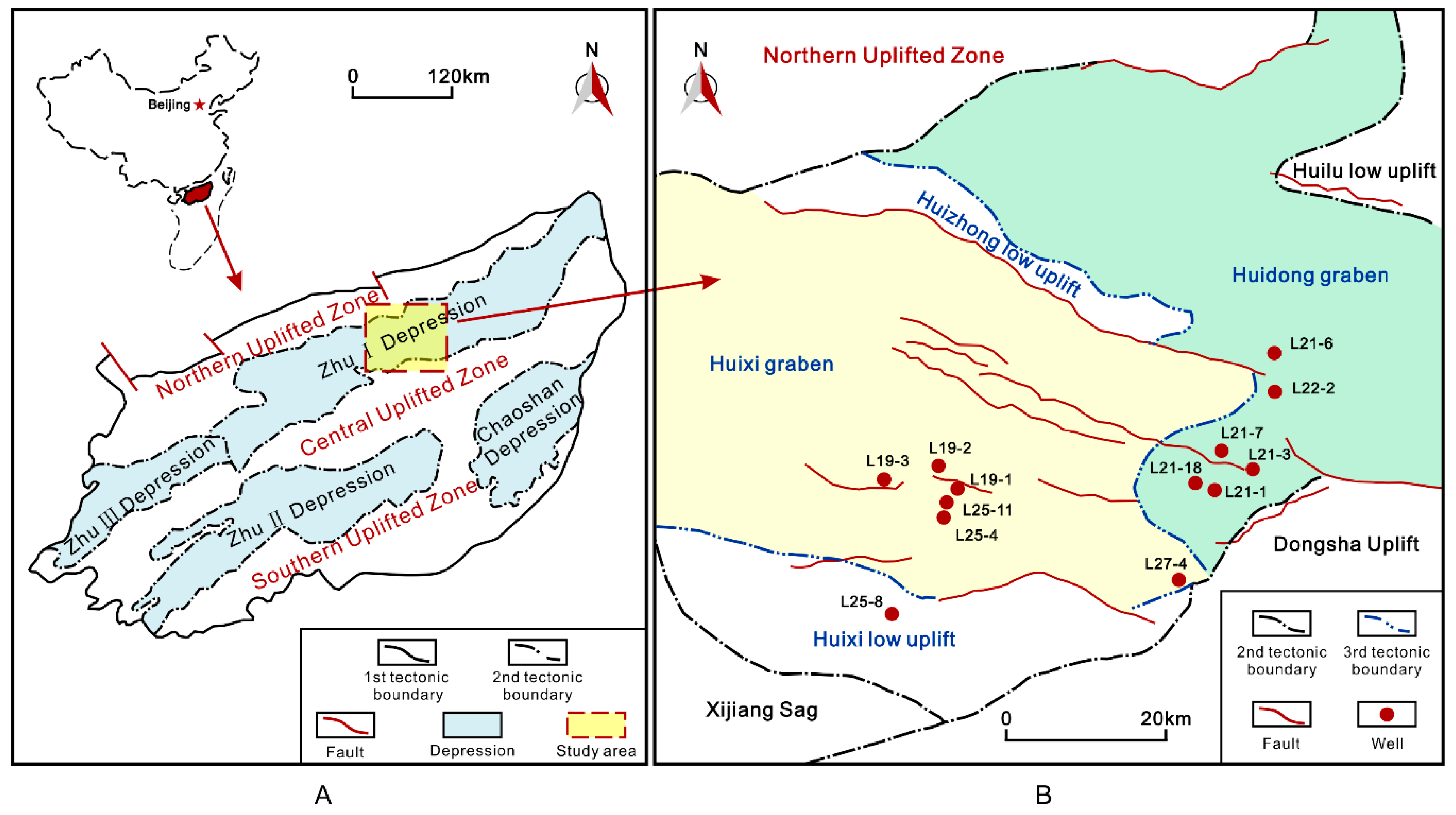
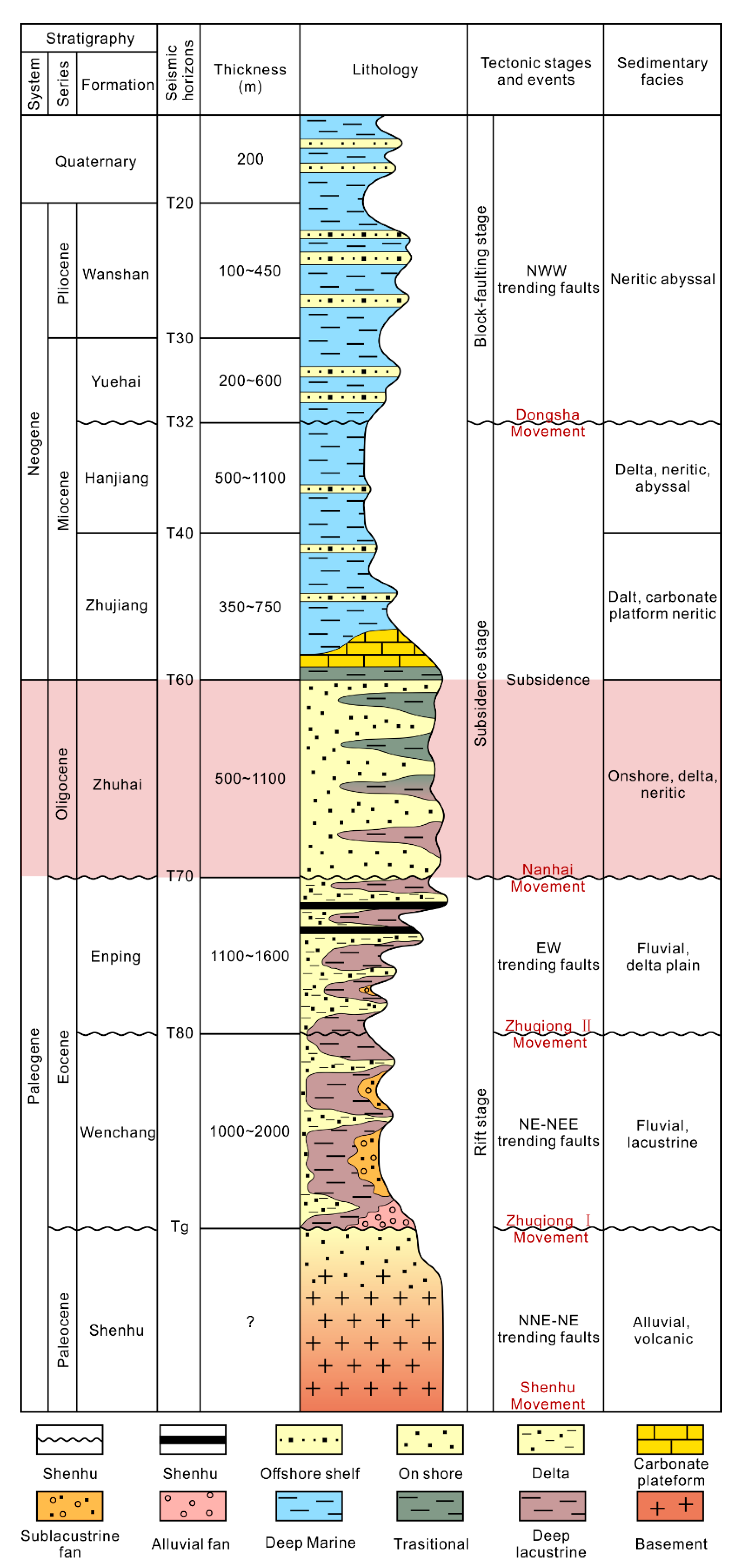
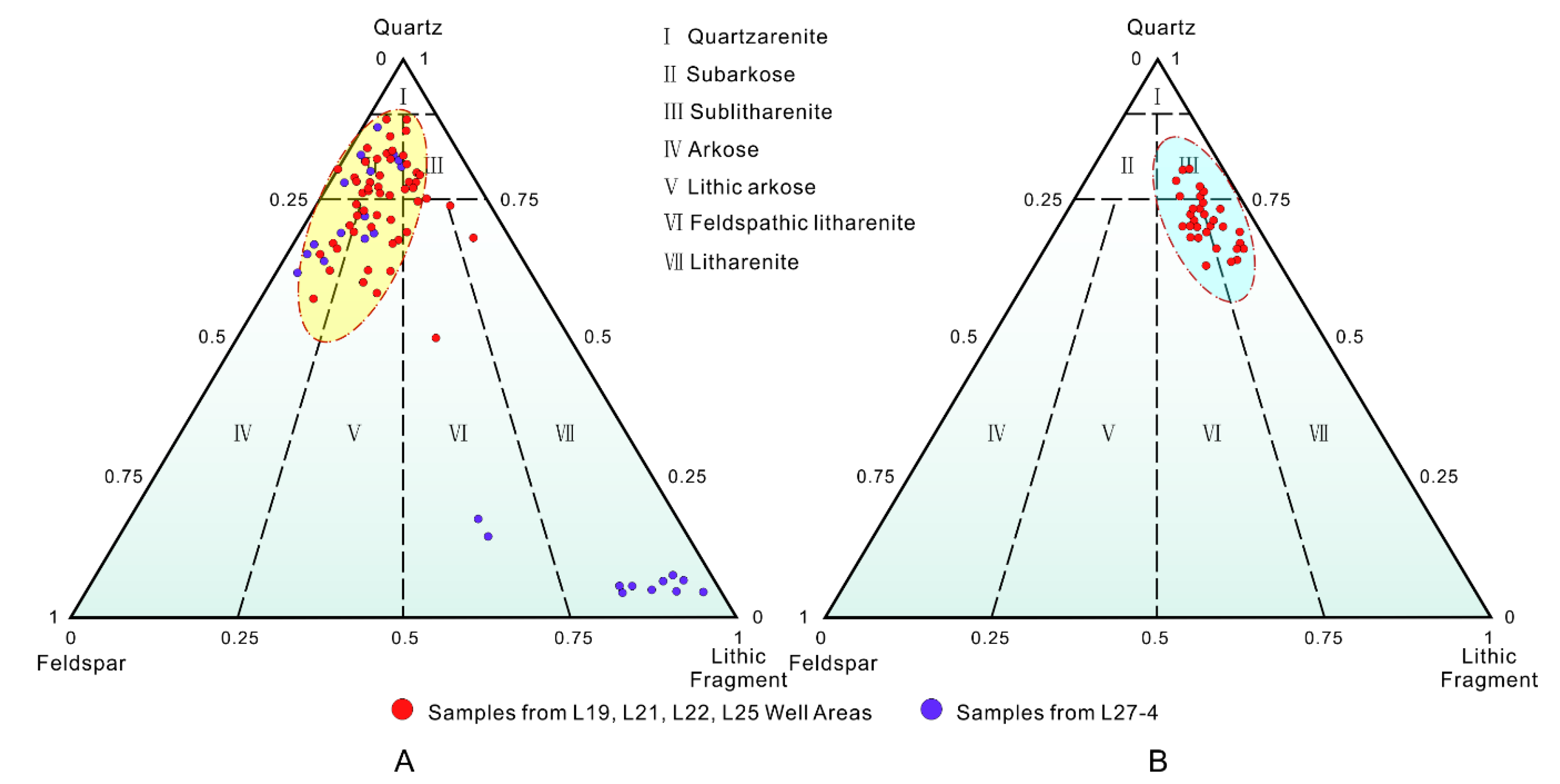
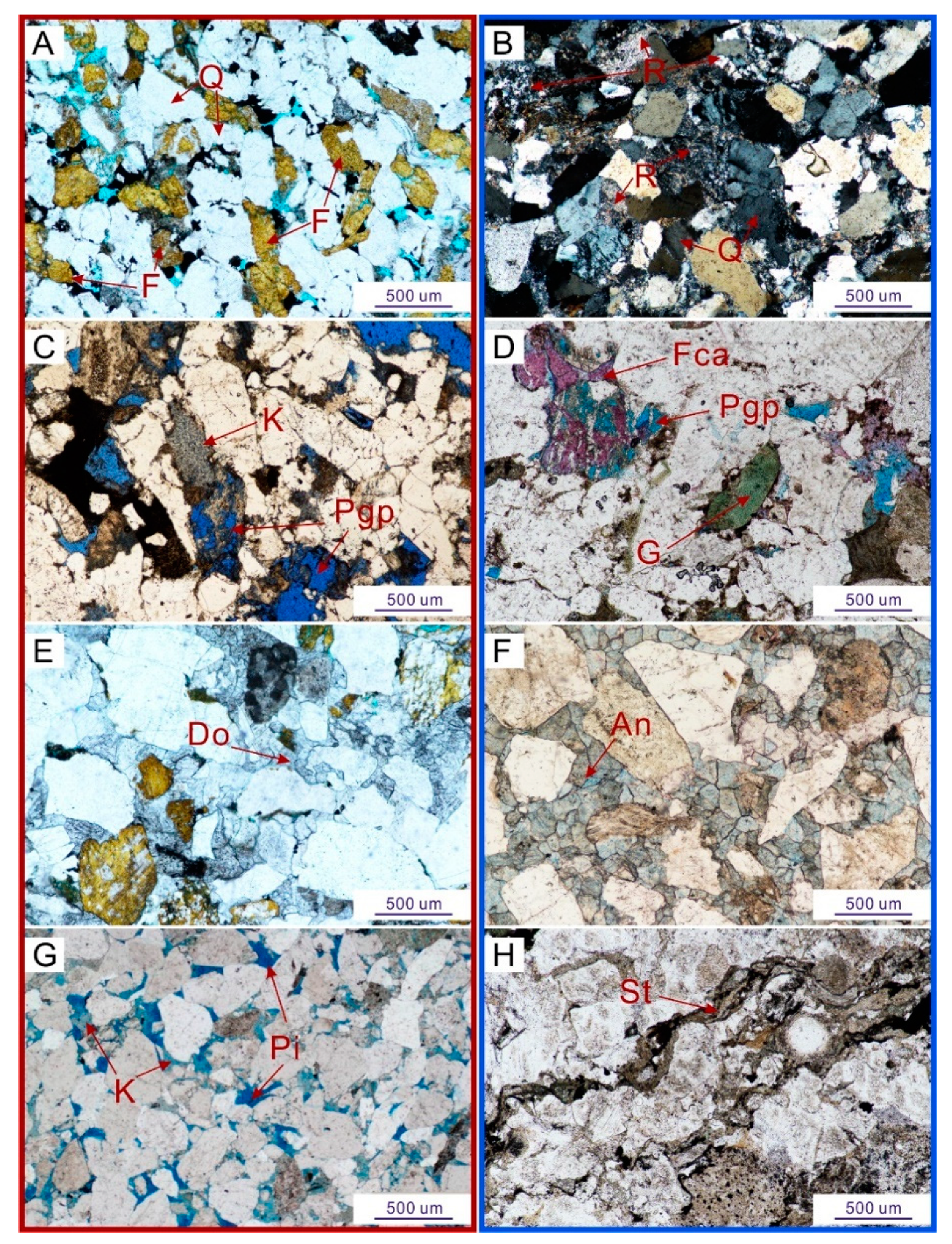

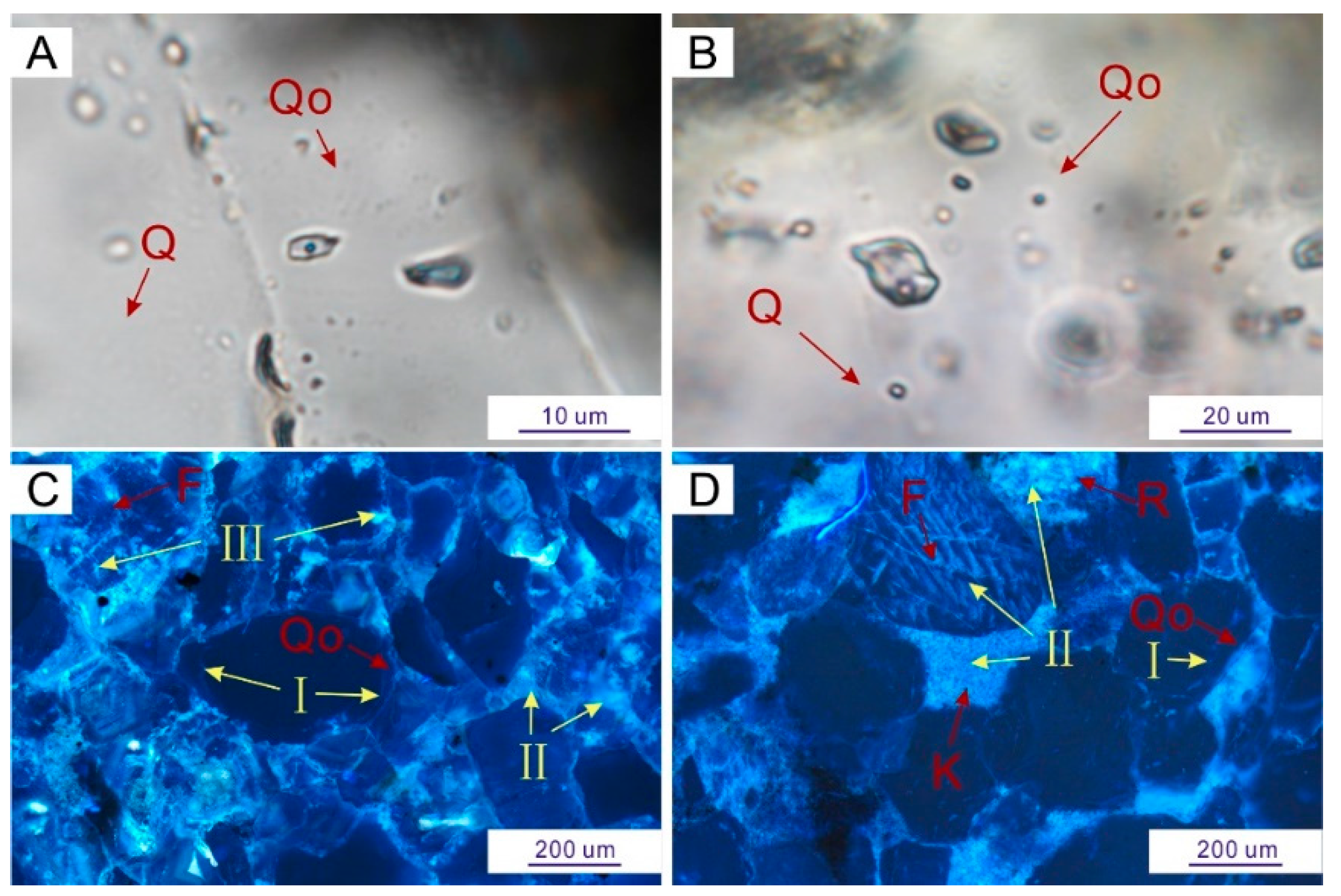
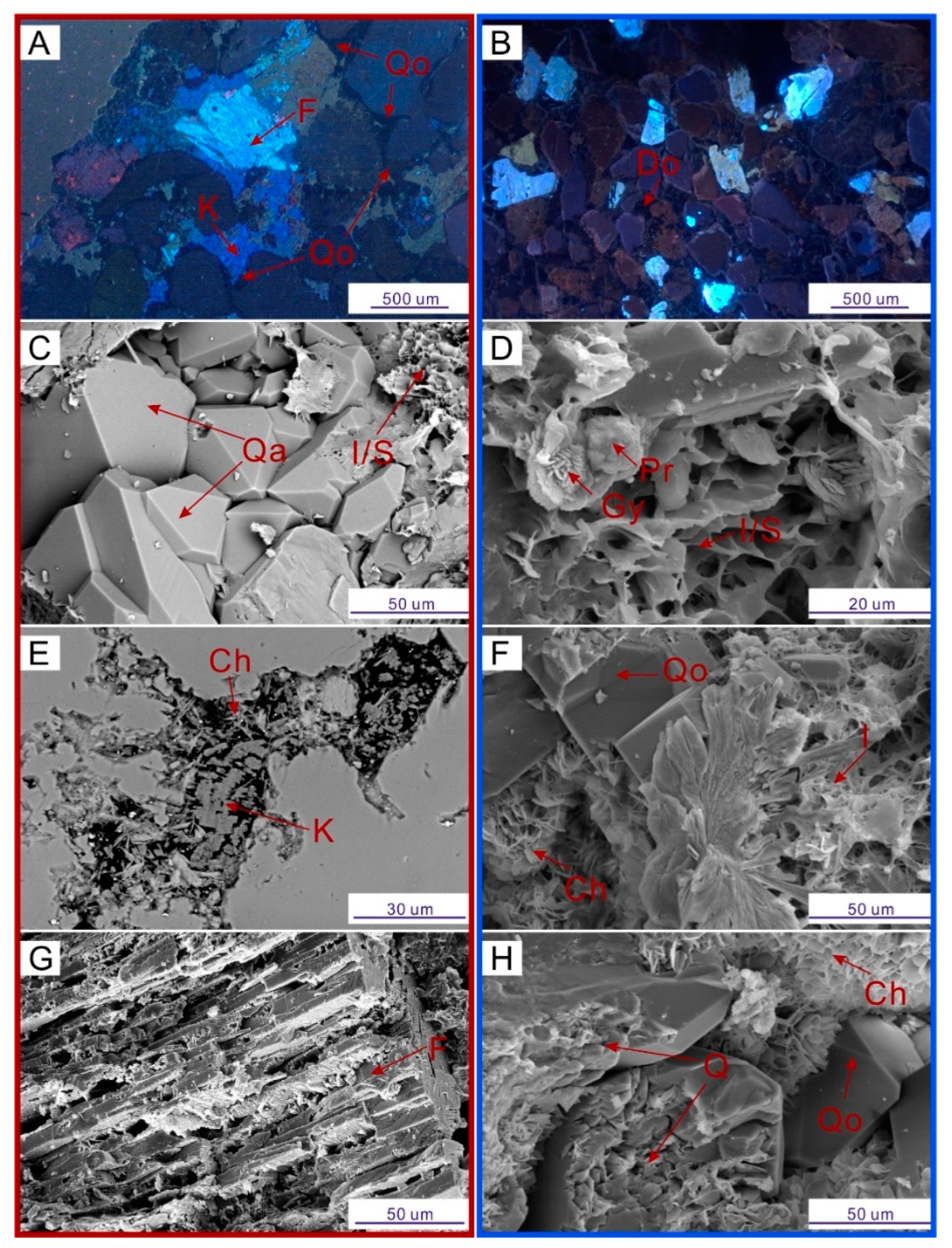
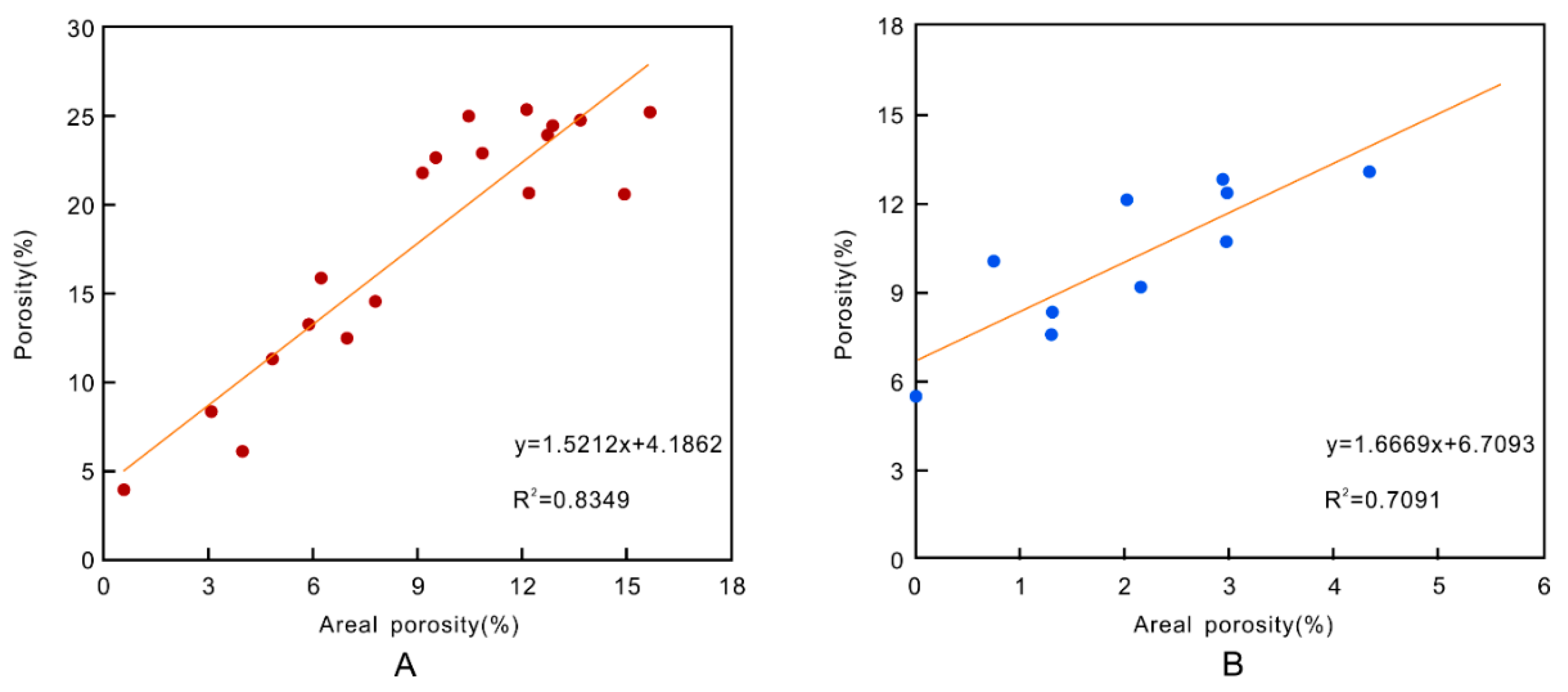
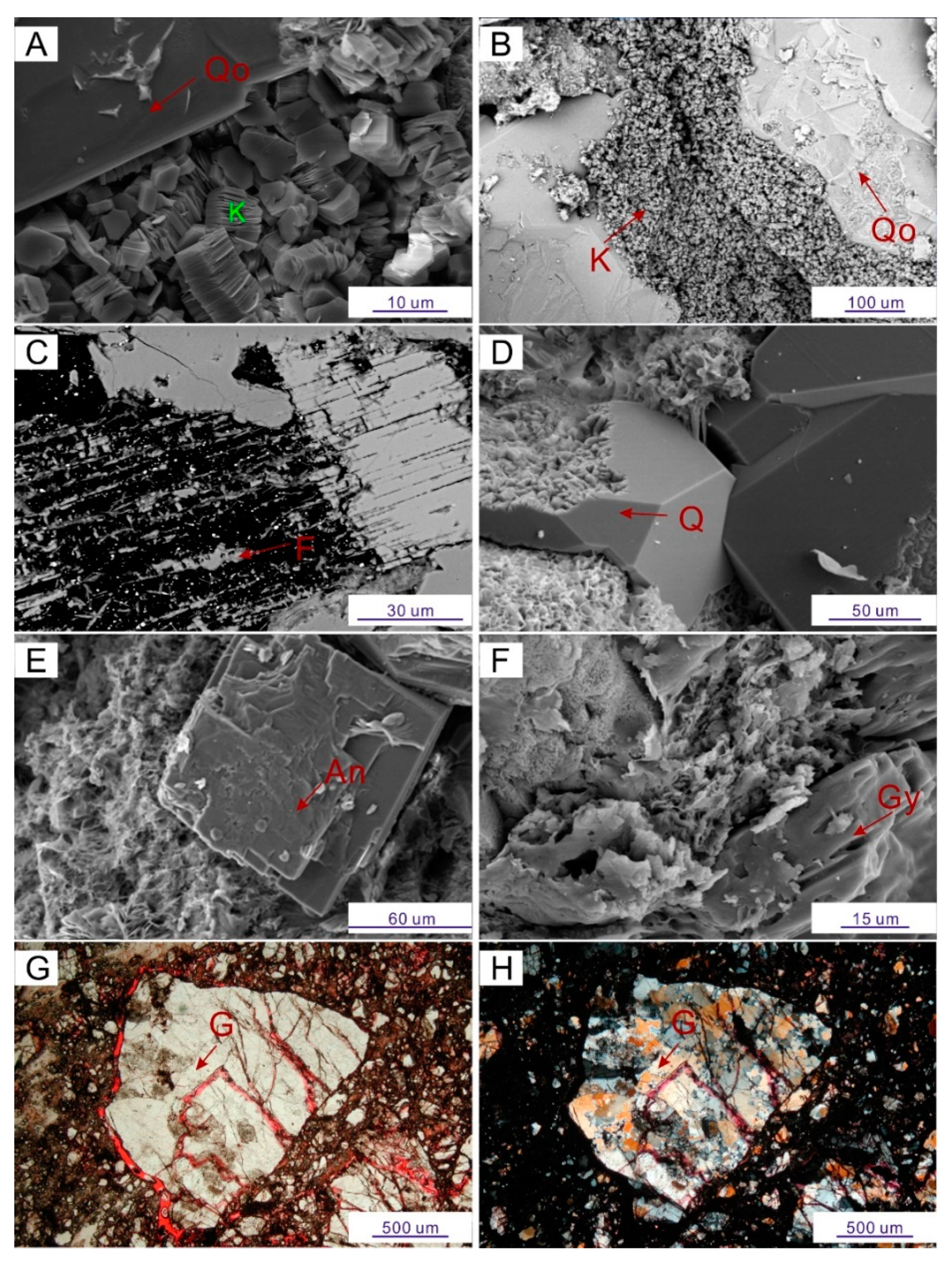
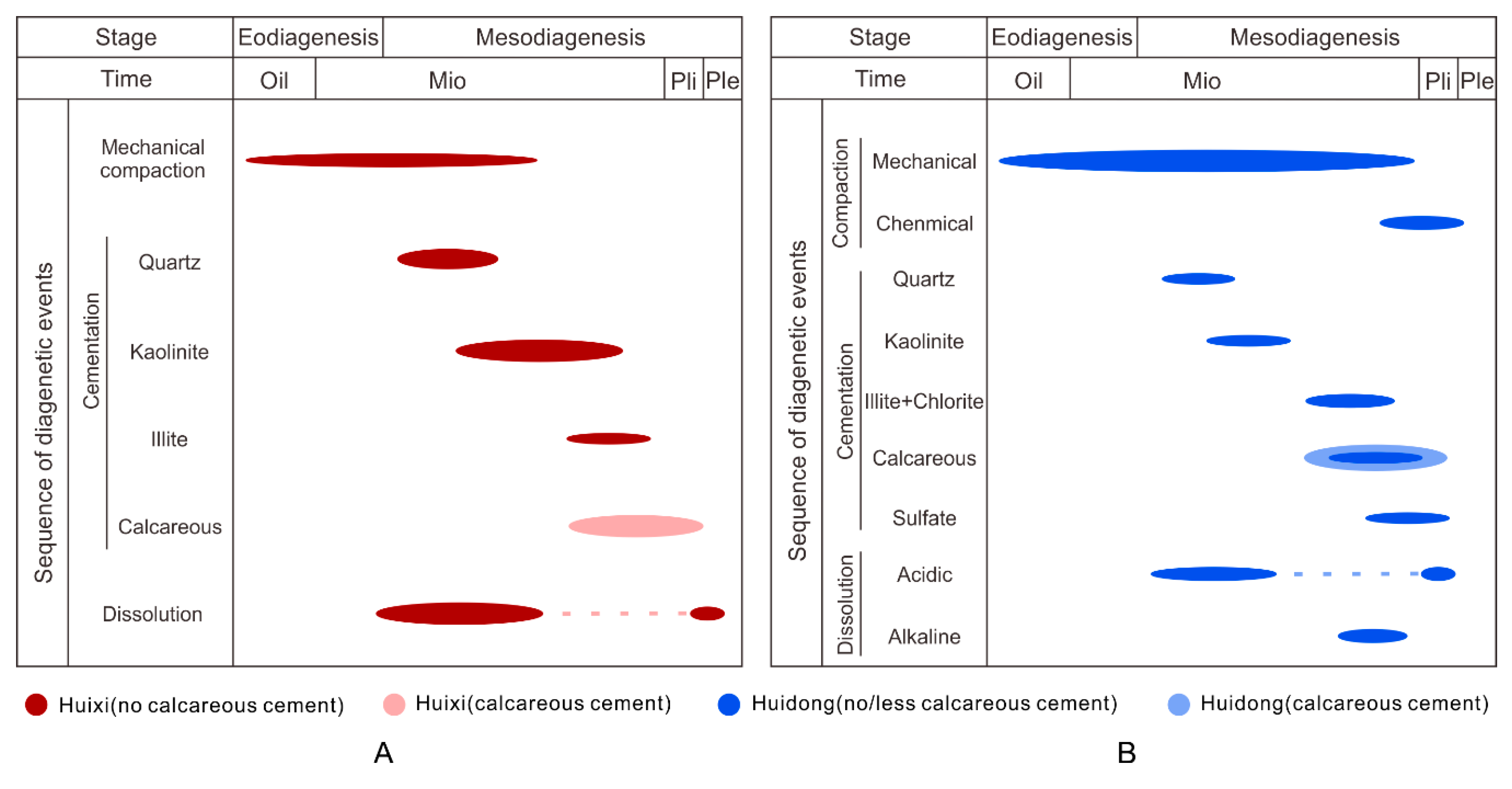

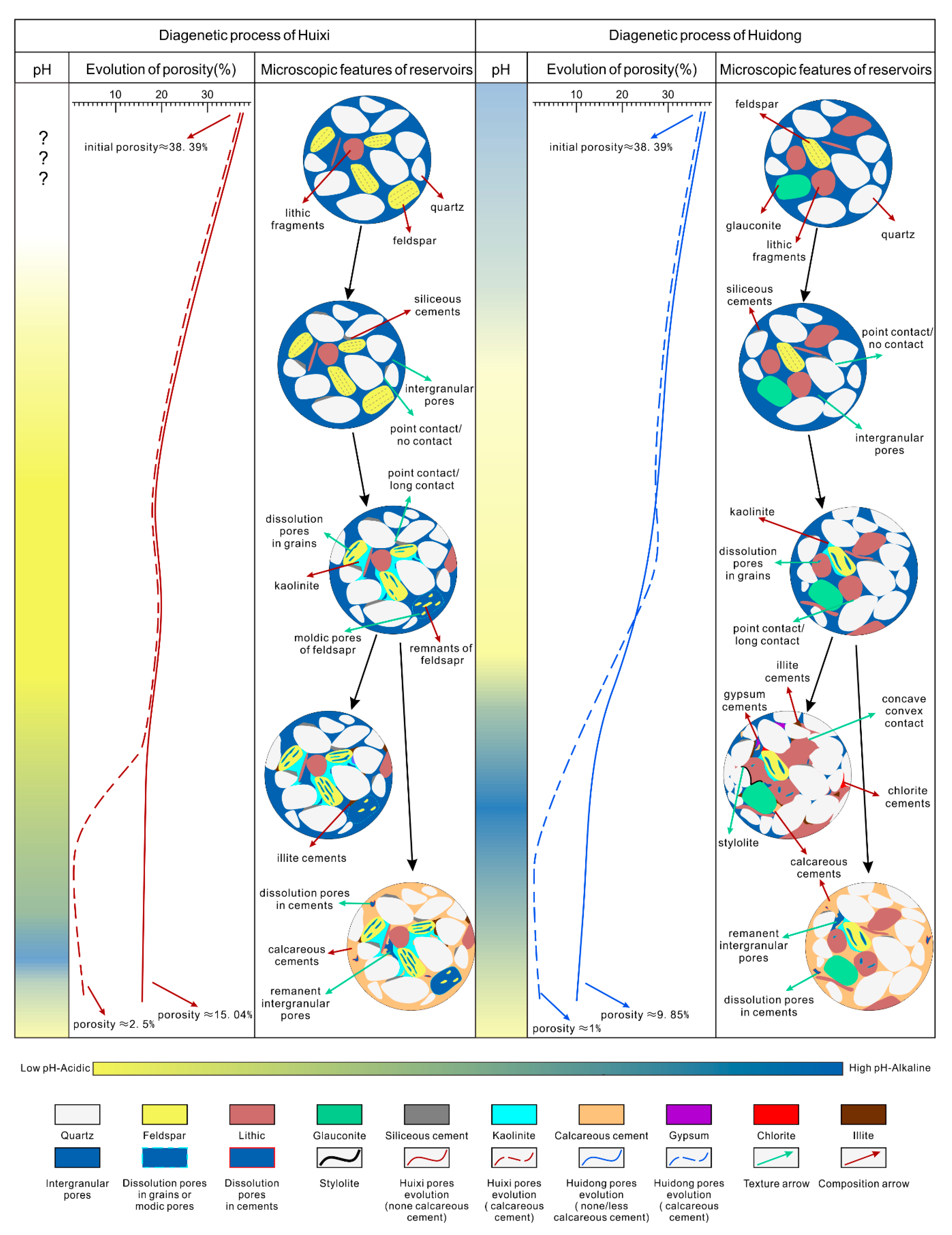
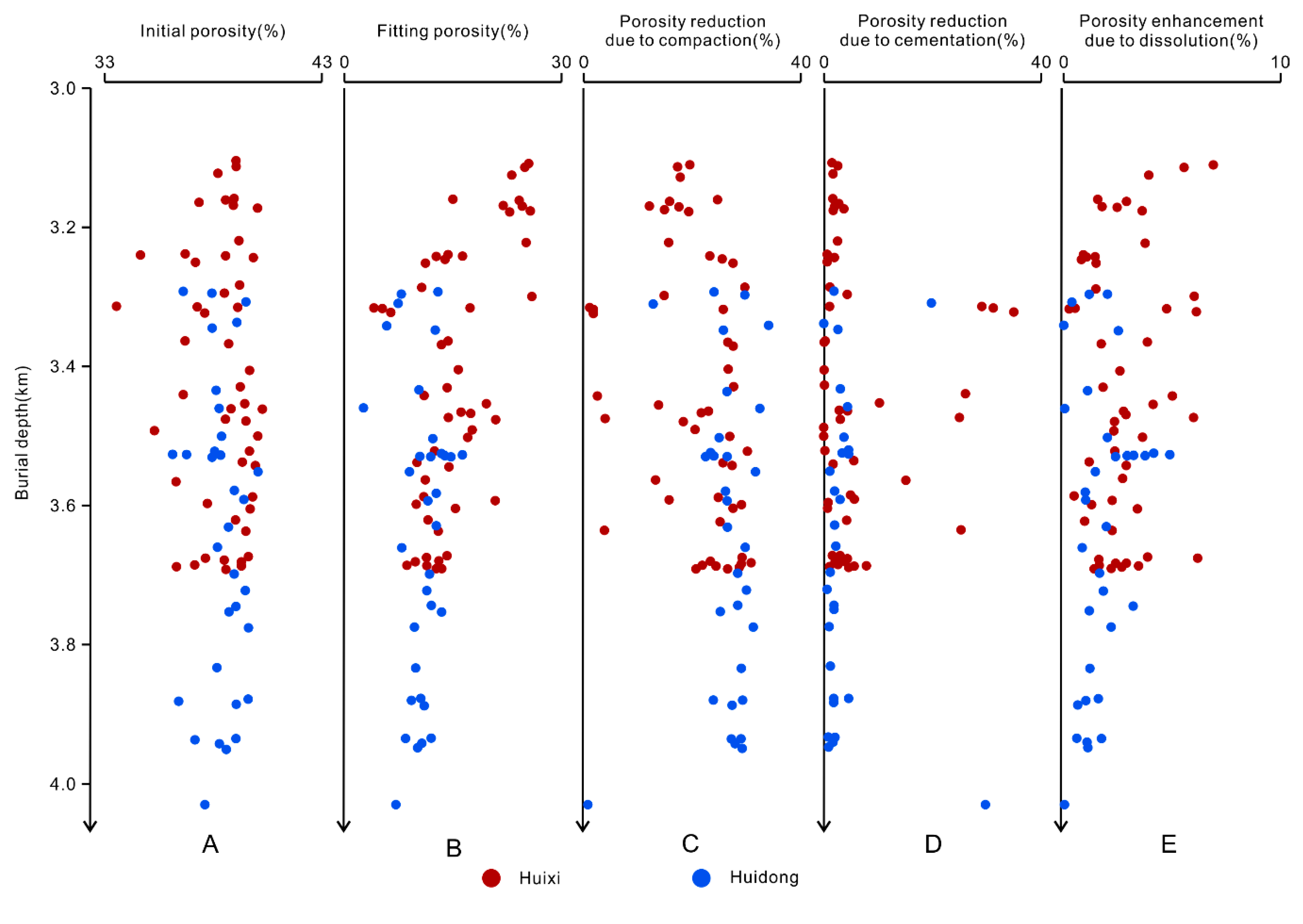
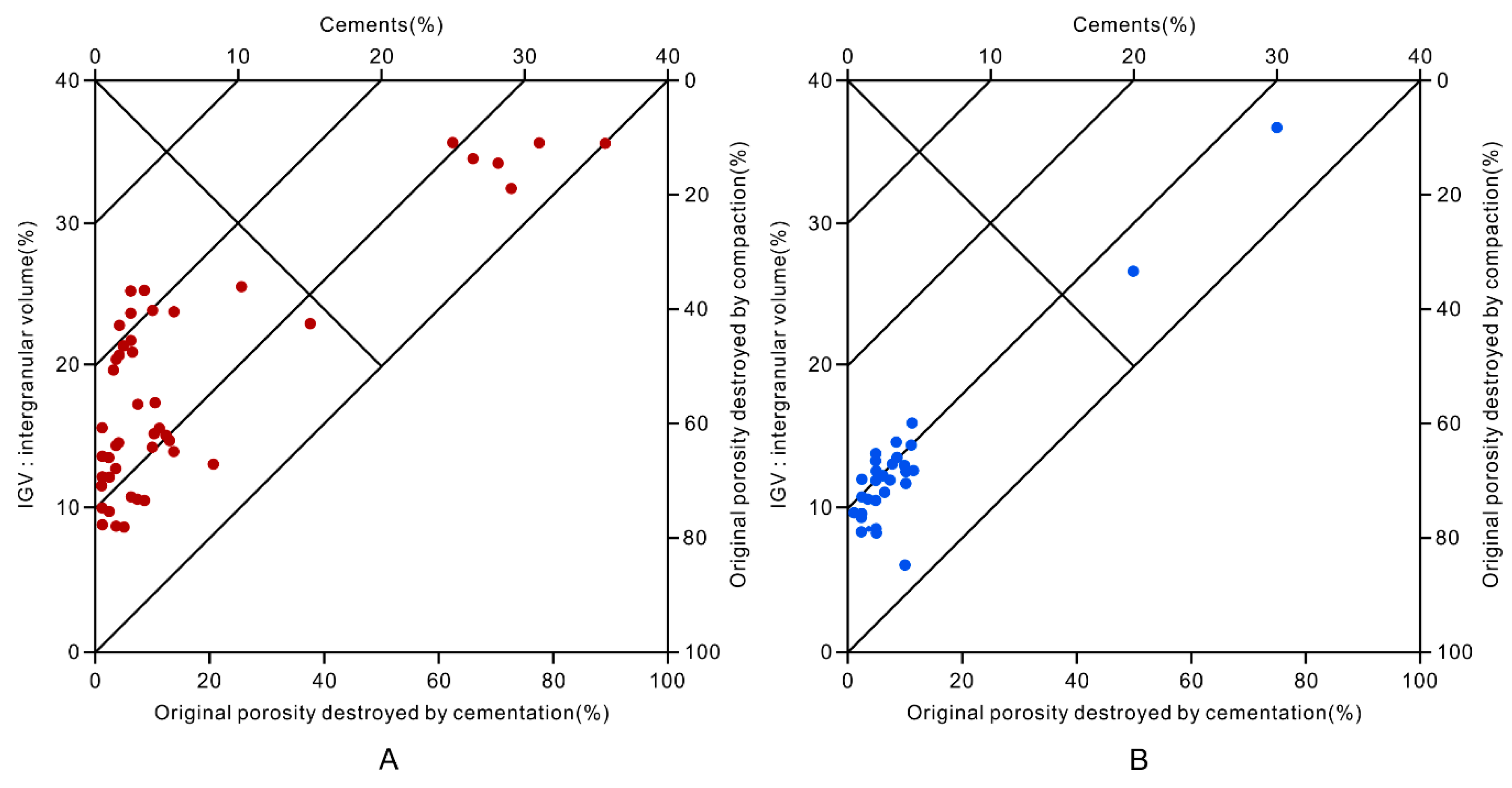
| Well | Depth (m) | Mineral Types | Th (°C) |
|---|---|---|---|
| L19-1 | 3464.20 | Quartz overgrowth | 114.10 |
| L19-1 | 3464.20 | Quartz overgrowth | 119.20 |
| L19-1 | 3464.20 | Quartz overgrowth | 114.20 |
| L19-1 | 3576.20 | Quartz overgrowth | 120.90 |
| L19-1 | 3576.20 | Quartz overgrowth | 119.30 |
| L21-3 | 3203.00 | Quartz overgrowth | 144.50 |
| L21-3 | 3203.00 | Quartz overgrowth | 143.50 |
| Well | Depth (m) | S0 | Pa (%) | Φa (%) | Φ1 (%) | Φ0 (%) | ΦL (%) | ΦCL (%) | ΦD (%) |
|---|---|---|---|---|---|---|---|---|---|
| L25-11 | 3157.00 | 1.28 | 8.82 | 17.60 | 14.60 | 38.82 | 24.18 | 1.65 | 1.61 |
| L25-11 | 3238.70 | 1.68 | 7.83 | 16.10 | 12.50 | 34.54 | 22.91 | 0.50 | 1.38 |
| L25-11 | 3312.40 | 1.83 | 0.58 | 5.07 | 3.90 | 33.46 | 0.95 | 29.08 | 0.47 |
| L25-11 | 3321.01 | 1.38 | 3.97 | 10.23 | 6.10 | 37.49 | 1.88 | 35.61 | 6.10 |
| L19-3 | 3104.80 | 1.27 | 15.65 | 27.99 | 25.30 | 38.93 | 19.16 | 1.30 | 6.83 |
| L19-3 | 3110.50 | 1.27 | 13.65 | 24.95 | 24.80 | 38.96 | 17.12 | 2.50 | 5.46 |
| L19-3 | 3121.00 | 1.33 | 10.83 | 20.66 | 22.90 | 38.17 | 17.66 | 1.50 | 3.89 |
| L19-3 | 3159.00 | 1.30 | 12.70 | 23.51 | 24.00 | 38.53 | 15.67 | 1.74 | 2.88 |
| L19-3 | 3165.00 | 1.40 | 12.88 | 23.78 | 24.50 | 37.27 | 11.98 | 2.50 | 1.72 |
| L19-3 | 3167.00 | 1.28 | 9.16 | 18.12 | 21.80 | 38.85 | 17.45 | 2.00 | 2.40 |
| L19-3 | 3171.00 | 1.20 | 12.14 | 22.65 | 25.40 | 39.95 | 14.61 | 3.50 | 3.56 |
| L19-3 | 3173.00 | 1.21 | 9.53 | 18.68 | 22.70 | 39.80 | 19.00 | 1.73 | 3.63 |
| L19-3 | 3218.00 | 1.26 | 10.51 | 20.17 | 25.00 | 39.04 | 15.29 | 2.50 | 3.75 |
| L19-2 | 3462.20 | 1.19 | 6.22 | 13.65 | 16.00 | 40.21 | 22.73 | 4.20 | 2.72 |
| L19-2 | 3476.90 | 1.24 | 12.20 | 22.74 | 20.70 | 39.38 | 18.35 | 2.60 | 2.28 |
| L19-2 | 3591.40 | 1.23 | 14.92 | 26.88 | 20.60 | 39.47 | 15.64 | 5.50 | 2.27 |
| L19-2 | 3686.38 | 1.42 | 3.51 | 9.53 | 8.30 | 37.05 | 23.89 | 8.26 | 3.40 |
| L19-2 | 3688.14 | 1.50 | 4.84 | 11.55 | 11.20 | 36.18 | 21.34 | 5.20 | 1.57 |
| L19-2 | 3690.62 | 1.50 | 5.87 | 13.12 | 13.30 | 36.18 | 20.50 | 4.50 | 2.13 |
| L21-7 | 3500.80 | 1.32 | 1.96 | 9.98 | 12.07 | 38.29 | 24.65 | 3.50 | 1.93 |
| L21-18 | 3290.49 | 1.46 | 2.54 | 10.94 | 12.80 | 36.59 | 23.84 | 2.00 | 2.05 |
| L21-18 | 3338.01 | 1.27 | 0.00 | 6.71 | 5.44 | 38.99 | 33.55 | 0.00 | 0.00 |
| L21-18 | 3344.99 | 1.35 | 2.43 | 10.76 | 12.40 | 37.85 | 25.43 | 2.50 | 2.48 |
| L22-2 | 3660.00 | 1.34 | 1.29 | 8.86 | 7.60 | 38.05 | 29.29 | 2.00 | 0.84 |
| L22-2 | 3753.00 | 1.29 | 4.33 | 13.93 | 13.08 | 38.61 | 24.71 | 2.00 | 1.18 |
| L22-2 | 3834.00 | 1.33 | 3.52 | 12.58 | 9.67 | 38.09 | 28.58 | 1.00 | 1.16 |
| L22-2 | 3882.00 | 1.49 | 2.15 | 10.29 | 9.16 | 36.29 | 23.55 | 4.59 | 1.01 |
| L22-2 | 3888.00 | 1.27 | 2.96 | 11.64 | 10.66 | 38.97 | 26.95 | 2.00 | 0.64 |
| L22-2 | 3937.50 | 1.41 | 1.29 | 8.86 | 8.32 | 37.11 | 28.54 | 2.00 | 1.75 |
© 2020 by the authors. Licensee MDPI, Basel, Switzerland. This article is an open access article distributed under the terms and conditions of the Creative Commons Attribution (CC BY) license (http://creativecommons.org/licenses/by/4.0/).
Share and Cite
Cao, X.; Zhong, D.; Liu, J.; Sun, H.; Song, Z.; Cao, T.; Wang, F.; Gong, S. Coupling between Diagenetic Environment and Porosity Evolution—A Quantitative Study of the Zhuhai Formation in the Huizhou Sag, Pearl River Mouth Basin, South China Sea. Minerals 2020, 10, 170. https://doi.org/10.3390/min10020170
Cao X, Zhong D, Liu J, Sun H, Song Z, Cao T, Wang F, Gong S. Coupling between Diagenetic Environment and Porosity Evolution—A Quantitative Study of the Zhuhai Formation in the Huizhou Sag, Pearl River Mouth Basin, South China Sea. Minerals. 2020; 10(2):170. https://doi.org/10.3390/min10020170
Chicago/Turabian StyleCao, Xuan, Dakang Zhong, Jie Liu, Haitao Sun, Zezhang Song, Tianyu Cao, Fei Wang, and Shuangyi Gong. 2020. "Coupling between Diagenetic Environment and Porosity Evolution—A Quantitative Study of the Zhuhai Formation in the Huizhou Sag, Pearl River Mouth Basin, South China Sea" Minerals 10, no. 2: 170. https://doi.org/10.3390/min10020170





